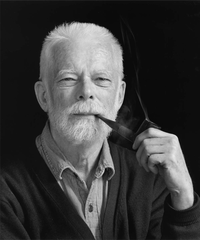Edward Nelson
Edward Nelson | |
|---|---|
 Edward Nelson | |
| Born | May 4, 1932 |
| Died | September 10, 2014 (aged 82) |
| Citizenship | American |
| Alma mater |
|
| Known for | |
| Spouses |
|
| Children | 2 |
| Awards | |
| Scientific career | |
| Fields | |
| Institutions | |
| Thesis | On the Operator Theory of Markoff Processes |
| Doctoral advisor | Irving Segal |
| Notable students | |
Edward Nelson (May 4, 1932 – September 10, 2014) was an American mathematician. He was professor in the Mathematics Department at
Biography
Edward Nelson was born in
He received his Ph.D. in 1955 from the University of Chicago, where he worked with Irving Segal. He was a member of the Institute for Advanced Study from 1956 to 1959. He held a position at Princeton University starting in 1959, attaining the rank of professor there in 1964 and retiring in 2013.
In 2012 he became a fellow of the American Mathematical Society.[5] He died in Princeton, New Jersey, on September 10, 2014.[6]
Academic work
Stochastic quantum mechanics
Nelson made contributions to the theory of infinite-dimensional
Four color problem
In 1950, Nelson formulated a popular variant of the
Foundations of mathematics
In the later part of his career, he worked on mathematical logic and the foundations of mathematics. One of his goals was to extend IST (
In September 2011, Nelson announced that he had proved that
Publications
Selected papers
- Nelson, Edward (1966). "Derivation of the Schrödinger Equation from Newtonian Mechanics" (PDF). Physical Review. 150 (4): 1079–1085. ISSN 0031-899X.
- Nelson, E. (1986). "Field Theory and the Future of Stochastic Mechanics". In Albeverio, S.; Casati, G.; Merlini, D. (eds.). Stochastic Processes in Classical and Quantum Systems. Lecture Notes in Physics. Vol. 262. Berlin: Springer-Verlag. pp. 438–469. OCLC 864657129.
Books
- Nelson, E. (1967). Dynamical theories of Brownian Motion. Princeton: Princeton University Press. OCLC 769464.
- Nelson, E. (1967). Tensor Analysis. Princeton: Princeton University Press. OCLC 988417.
- Nelson, E. (1969). Topics in Dynamics: I: Flows. Princeton: Princeton University Press. OCLC 59197.
- Nelson, E. (1985). Quantum Fluctuations. Princeton: Princeton University Press. OCLC 11549759.
- Nelson, E. (1986). Predicative Arithmetic. Princeton: Princeton University Press.
- Nelson, E. (1987). Radically Elementary Probability Theory. Princeton: Princeton University Press. OCLC 15591889.
See also
- Hidden variable theory
- Influence of non-standard analysis
- Stochastic process
- Stochastic quantum mechanics
- Stochastic electrodynamics
References
Notes
- ^ Edward Nelson (2000). "Mathematics and Faith" (PDF). Presented at the Jubilee for Men and Women from the World of Learning, held at the Vatican, 23–24 May 2000. Retrieved March 5, 2020.
{{cite web}}: CS1 maint: location (link) - ^ Edward Nelson (2009). "Completed Infinity and Religion". Retrieved March 5, 2020.
- ^
Nelson, Edward (October 17, 2009). Mathematics and Religion (Speech). The Philoctetes Center for the Multidisciplinary Study of the Imagination. 31 minutes in.
In terms of religion, I'm a Christian. Worship and prayer are very important to me.
- ^ Aizenman, Michael; Kochen, Simon; Lieb, Elliott; Simon, Barry; Gunning, Robert (2014). "Edward Nelson 1932-2014". Princeton University Department of Mathematics. The Trustees of Princeton University. Retrieved March 5, 2021.
- ^ AMS 2012.
- ^ Princeton University 2014.
- ^ Soifer 2009, p. 23.
- Bibcode:2016arXiv160407134W.
- ^ Nelson 2011.
- ^ Baez 2011.
- ^ Wilkie 1990.
Sources
- American Mathematical Society (2012). "List of Fellows of the American Mathematical Society". ams.org. American Mathematical Society. Archived from the original on December 5, 2012.
- Baez, J. (2011). "The Inconsistency of Arithmetic". golem.ph.utexas.edu. The n-Category Café.
- S2CID 42672640.
- Kelly, M. (2014). "Edward Nelson, Nonconformist who Sparked a Quantum Field Theory Revolution, Dies at 82". princeton.edu. Princeton University. Archived from the original on June 7, 2017.
- Nelson, E. (2011). "Inconsistency of P". cs.nyu.edu. Foundations of Mathematics. Archived from the original on May 13, 2017.
- Princeton University (2014). "Professor Emeritus Edward Nelson Passed Away September 10th". math.princeton.edu. Archived from the original on September 11, 2014.
{{cite web}}: CS1 maint: ref duplicates default (link) - OCLC 233933503.
- ISSN 0273-0979.

